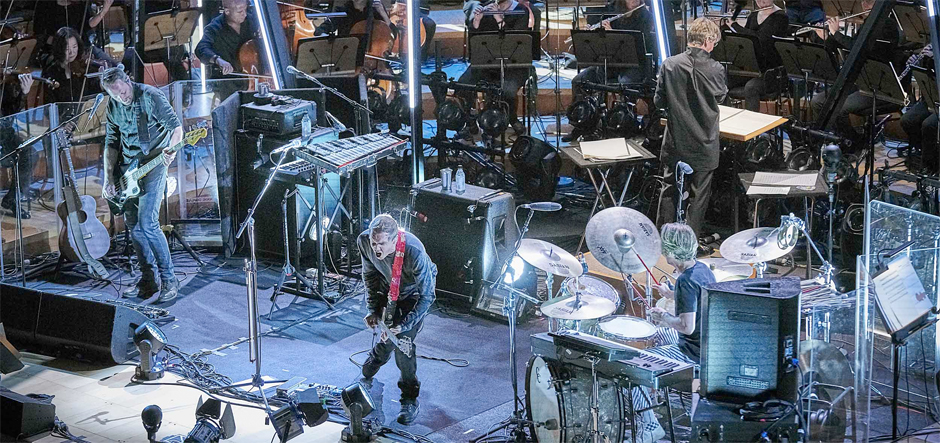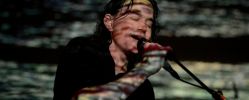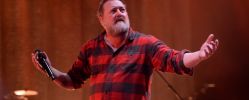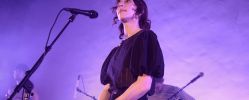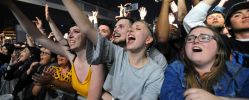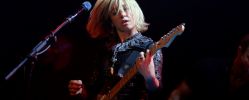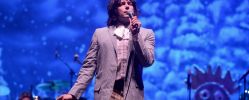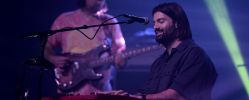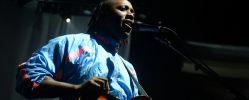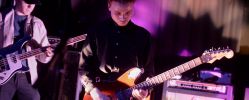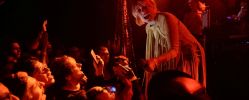
Live Review: Sigur Rós & LA Phil (Reykjavík Festival) @ Walt Disney Concert Hall, April 13, 2017
The highlight of the LA Phil’s ongoing Reykjavík Festival, Sigur Rós stunned in a transcendent performance in the first of a three-night run at Walt Disney Concert Hall. The Icelandic band, often branded as “post-rock” (if anything demonstrates the deficiencies of that catch-all term, it was this particular night) overwhelmed with two dynamic hour-long sets. First, backed by the orchestra–conducted by Esa-Pekka Salonen, co-curator the festival, in a return home as the LA Phil’s conductor laureate–and then as their current stripped-down three-piece configuration.
The night is billed as “Sigur Rós & LA Phil,” not “Sigur Rós with the LA Phil,” a hint at a long evening coming in around three and a half hours with intermissions, Sigur Rós not appearing until about 75 minutes into the program. Starting with a sort of a cappella amuse-bouche from the Schola Cantorum Reykjavík choir in a set of five short pieces quickly demonstrating a range of traditional Icelandic music. It was met with a mostly appreciative, if slightly fidgeting response from. Things picked up with the orchestra and the familiar sight of Salonen back in Los Angeles in black.
Their opener this night (they will perform different pieces each night with Sigur Rós) was “BD” by Hlynur Aðils Vilmarsson, a searching avant garde number that runs from atonal discord to melodic whimsy, building to a tribal gallop of short notes, which at times felt like something that might soundtrack an episode of Lost. Next, they tackled the three-part “Emergence,” by Daníel Bjarnson, a young Icelandic composer/conductor who’s crossed over to pop to work with the likes of Ólöf Arnalds and Efterklang, as well as Sigur Rós. A U.S. performance debut, it’s a slow tense drone largely for strings with a short chaotic middle section. The final section of overlapping descending lines was particularly gorgeous. Finally, after an intermission, the three members of Sigur Rós joined the LA Phil on stage.
They opened with a relatively new song being played live, “Á”–“river” in Icelandic–while revealing the lighting scheme of a cluster of vertical beams set at tilted angles to echo the lines in the hall’s famous “french fry” organ pipe design (sadly the organ is untouched tonight; it cried out for a take of their classic “Svefn-G-Englar,” with its opening church organ chords, but, alas, the song is long out of the band’s live rotation)
“Á” is brooding for a Sigur Rós song, serving as a sort of touch stone for the current tour of the band, coloring their familiar sound with a some new darker tones. Arranged for orchestra by Bjarnson–all the orchestral pieces tonight are arranged by invited guests, among them Anna Meredith, Owen Pallett, Dan Deacon, Nico Muhly–its drone softened by strings compered to electric guitar-led live versions. The challenge of integrating the rock instruments with the orchestra emerged as Orri Dýrason’s drumming threatened to overpower the orchestra in places. Indeed, there were a few spots when the orchestra seemed to be reduced to a backing track to the powerful amplified playing of the band.
Next: a gentle, ethereal rendition of Valtari (2012) standout “Ekki Múkk.” What followed: the peak of the orchestral set, the night as a whole, and a top personal live music experience, “Takk/Glósóli,” the opening instrumental overture and first song of the 2005 album of the same name. Arranger Páll Ragnar Pálsson’s rendering of the recorded version’s synthesized ascending lines in higher pitched violins intensified the dramatic build before the cathartic release of singer Jónsi Birgisson’s wailing vocals and violin-bowed electric guitar at the song’s crescendo.
Of the remaining pieces in the eight-song orchestra set, “Staraflur” garnered immediate cheers of recognition, conjuring their 1999 album, Ágætis byrjun, the introduction for most to Sigur Rós, as well no doubt many recalling Wes Anderson’s The Life Aquatic with Steve Zissou where it features prominently on the scored. Dan Deacon’s take on a “Festival,”augmented it with new brass and violin top lines over a driving gallop held down by Dýrason (by this point shirtless) and bass player/multi-instrumentalist Georg Hólm, closing out the orchestral portion on a triumphant note. After a last intermission and a dimming of the lights, then, finally, Sigur Rós, alone.
The closing act–six songs, including live mainstays such as “Vaka,” “Ny Batteri,””Kveikur” and the traditional closer of “Popplagið”–was a little more of Sigur Rós by the numbers, though even their usual performance is extraordinary by the standards of most. The band was perhaps little to reliant on sheer volume and power in this portion, but it’s hard to blame them for wanting to push the renowned acoustics of the hall.
Maybe it’s besides the point to pick apart the technical points of the orchestral arrangement in a crossover performance like this–though I’d wager they did just fine by my novice infrequent-classical-performance-attending ears–and just skip straight to how the performance either succeeds or fails a whole, or, plainly: how it makes the listener feel. Suffice to say, the show was victorious and profoundly affecting. One senses these intimate shows–4,500 each night; by contrast the sold-out Hollywood Bowl held over 17,000–will grow in legend the farther they recede into memory.
Sigur Rós | sigur-ros.co.uk
LA Phil | laphil.com
Photo from sigur-ros.co.uk
